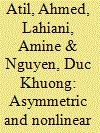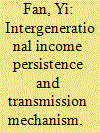| Srl | Item |
| 1 |
ID:
127283


|
|
|
|
|
| Publication |
2014.
|
| Summary/Abstract |
In this article, we use the recently developed nonlinear autoregressive distributed lags (NARDL) model to examine the pass-through of crude oil prices into gasoline and natural gas prices. Our approach allows us to simultaneously test the short- and long-run nonlinearities through positive and negative partial sum decompositions of the predetermined explanatory variables. It also offers the possibility to quantify the respective responses of gasoline and natural gas prices to positive and negative oil price shocks from the asymmetric dynamic multipliers. The obtained results indicate that oil prices affect gasoline prices and natural gas prices in an asymmetric and nonlinear manner, but the price transmission mechanism is not the same. Important policy implications can be learned from the empirical findings.
|
|
|
|
|
|
|
|
|
|
|
|
|
|
|
|
| 2 |
ID:
159042


|
|
|
|
|
| Summary/Abstract |
Analyzing monetary policy in China is not straightforward because the People's Bank of China (PBoC) implements policy by using more than one instrument. In this paper we use a Qual VAR, a conventional VAR system augmented with binary policy announcements, to extract a latent indicator of tightening and easing pressure, respectively, for China. The model acknowledges that policy announcements are endogenous and summarizes policy by a single indicator. The Qual VAR allows us to study the impact of monetary policy in terms of unexpected changes in these latent variables, which we identify using sign restrictions. We show that the transmission of monetary policy impulses to the rest of the economy is similar to the transmission process in advanced economies in terms of both output growth and inflation despite a very different monetary policy framework. We find that bank loans are not sensitive to policy changes, which implies that window guidance is still a necessary policy tool. We also find that the impact of monetary policy shocks is asymmetric in terms of asset prices, that is, the asset price reactions differ in their sensitivity to tightening shocks and easing shocks, respectively. In particular, an easing of monetary conditions boosts stock prices while a tightening shock leaves stock prices unaffected. This shows that monetary policy is not a suitable tool to stabilize asset prices, which raises implications for financial stability and macroprudential policy.
|
|
|
|
|
|
|
|
|
|
|
|
|
|
|
|
| 3 |
ID:
149776


|
|
|
|
|
| Summary/Abstract |
In this paper I investigate the intergenerational income association and its transmission channels amid China's economic transition period using urban data from the Chinese Household Income Projects in 1995 and 2002. The estimated intergenerational income elasticity is 0.43 and 0.51 for cohorts educated prior to and after the market reform respectively, and reaches 0.71 among households with above average income in the post-reform era. Besides the conventional channel of education, this paper estimates the contribution from social capital and ownership of work unit across cohorts and income groups. There is weak evidence that prior to market reform, ownership of work unit contributes most to the intergenerational income persistence for households with below average income, while social capital leads the three contributors in households with above average income. However, in the post-reform era, parents with below average income invest statistically significantly in children's education which contributes most to the intergenerational income persistence. The leading contributor in families with above average income shifts to social capital. Possible explanations for such a shift lie in the ability and incentive of parents from different income categories to invest in their children. The results are tested through a series of robustness checks, and provide empirical support for promoting policies on the equality of opportunity.
|
|
|
|
|
|
|
|
|
|
|
|
|
|
|
|